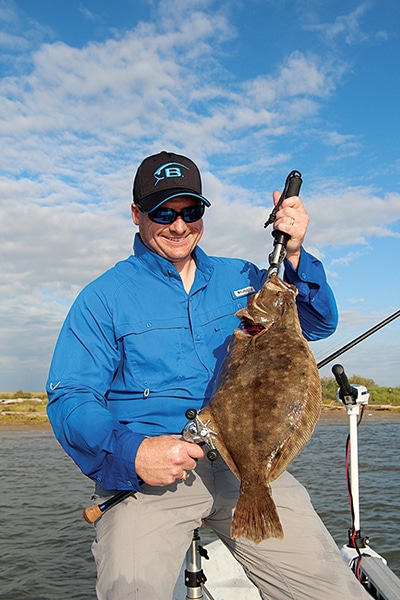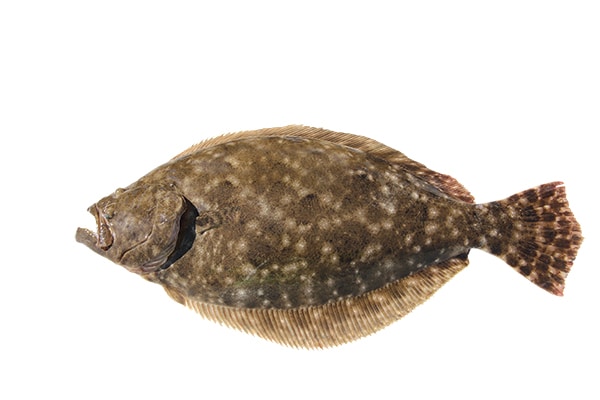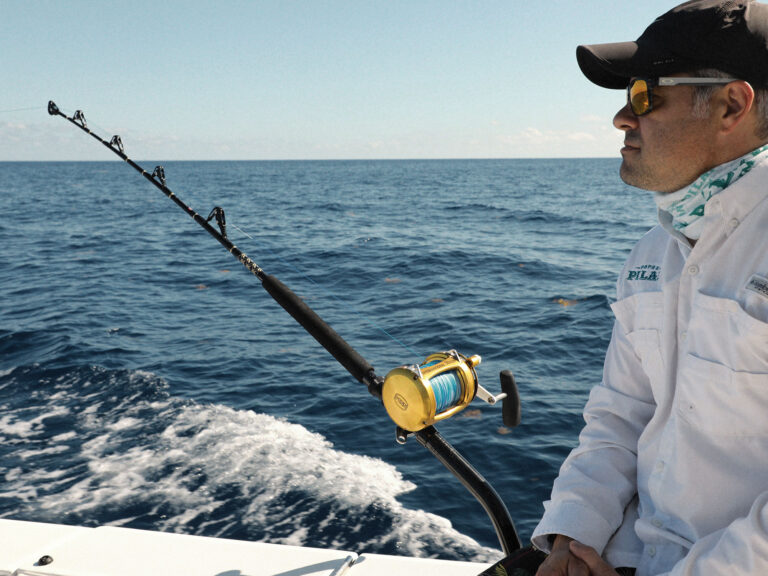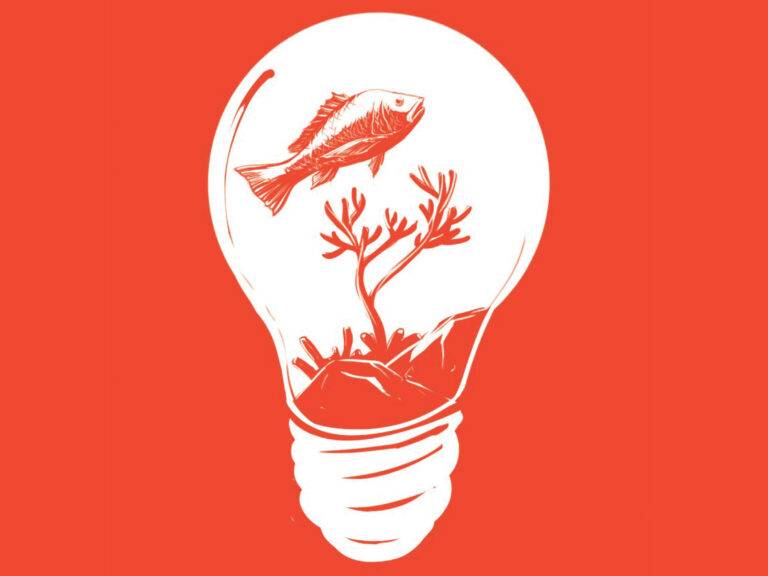Flounder are some of the most quirky fish on Earth. Jigs catch more flounder than any other lure — that’s a fact. But live baits, like shrimp, mud minnows and finger mullet, catch them as well. And small crankbaits fished along bottom prove deadly. It’s all about being in the right place on the right tide.
A classic example is fishing a drain that feeds into a bay. Here’s the situation: Not long ago, I pulled up on a drain that was no wider than 5 feet, but it fed into a bay from a sprawling backwater estuary lake. The drain had formed a washout the size of a small cabin, and it was flat-loaded with flounder.
I idled my 22-foot center console into position, put the Power Pole down, and staked out the bow to position us in a way that allowed us to toss out soft plastics dressed to catch flounder. It didn’t take long to realize we were in the right place at the right time. Our little curly-tail jigs were drawing solid thumps on just about every cast.
One day this past spring, I was at a boat ramp in Sabine Pass, located on the Texas-Louisiana border. Two guys had just put their boat on the trailer, and I asked how they had done. One of them reached over and opened the lid of the fish box. “Check this out,” he said, and held up a 61⁄2-pounder. “Loaded up on big flatties today.”
Their flounder fishing tactics were simple, he explained. They fished white curly-tail jigs on 1⁄8-ounce jig heads on a single point jutting out into the pass on an outgoing tide. The go-to tactic was to cast the bait out, let it settle to the bottom, and bump it in while the current moved it across the point.
Best Lures for Flounder
Most anglers will say the best flounder lures are jigs, and jigs catch flounder just about anywhere. But there are some tricks you can incorporate into your game to increase your success. Applying spray-on liquid scent to your jig or tipping your jig with a piece of shrimp works great. The best flounder fishermen I know refuse to cast without using some sort of spray-on scent. One of the best is the Yum F2 Ferocity in either garlic or shrimp. Squirt a dose on the jig about every three or four casts.
Another scent option is to use a dime-size piece of table shrimp to tip a jig. Note that I said table shrimp, as in fresh — flounder turn up their nose at rotten shrimp. Flounder find the clean aroma that fresh shrimp emit irresistible. Pinch the tail section off, peel it and slip it over the bend of the hook. That way it will ride on top of the jigs as it bumps along the bottom. When the shrimp teaser becomes soggy, switch it out.
Jig bodies vary in shape and size. A curly-tail is popular because it delivers vibration similar to a spinner bait. A paddle-tail delivers more of a thump, thump, thump vibration.
At times it’s best to match the hatch with a jig, especially on a clear to sandy-green tide. In that situation, flounder have good visibility and can see what they are about to eat. That’s when you show them something they’re familiar with. Mud minnows and finger mullet make up the majority of the flounder’s diet. The Yum Mud Minnow ranks as one of the best match-the-hatch jigs for flounder. It looks like the real deal, and it’s built with a paddle tail.
Pitching jigs for flounder is not a specialty, but it’s deadly and dead simple. It’s the same drill that freshwater anglers use to target bass: You move along the shoreline, and pitch jigs to spots that have the potential to hold fish. This works best when fishing along a shoreline with a sharp drop. It’s especially good in bayous and drains that feed into bays. Use your trolling motor to stay in position while easing down the bank. Pitch jigs to small pockets that flounder use for ambush spots. It’s usually best to do this on a high tide when you’ve got lots of water and the fish are up in the pockets.
Carolina Rig for Flounder
There are many ways to fish jigs. The easiest method is to tie one on, cast it out, and slowly reel it in. That’s a good way to cover lots of water. A lot of flounder pros stake out their boat on a likely spot, and fan-cast a jig, swimming them along the bottom. If they catch a couple of flounder, they switch to a slower retrieve, in order to precisely and thoroughly work all the water within casting range.
A Carolina rig — best known for catching bass — doubles as a good flounder rig. But if you’re new to flounder fishing, you’re likely wondering how to tie a flounder rig. I like to rig them with a ¼-ounce bullet weight so the rig moves with the current as it bounces along the bottom. This is also a good option on days with weak tides when flounder are on a soft bite. With the Carolina rig, flounder eat the jig and feel little or no tension. That allows them to solidly take the bait, which allows the angler to get a better hook-set.
The Carolina rig duplicates one of the most successful live-bait rigs ever put together for catching flounder. It’s basically a weight rigged above a swivel, with a leader and hook or jig. The components for this rig include a ¼-ounce barrel or bullet weight, a 20-pound-class black swivel, an 18- to 20-inch section of fluorocarbon leader, and a 2/0 live-bait hook or jig head.
To assemble the rig, thread the running line through the weight, and tie it off to the swivel. Next, tie one end of the leader to the bottom of the swivel and the other end to the hook or jig. That’s it. This rig can be used with live baits and jigs. It’s especially effective when used on points, at the mouths of drains, and in a pass when you have enough tide to move the rig along the bottom.
Flounder hold on and around all types of structure. Some of the best are drains, bulkheads, barges, points and passes.
Flounder Highway
Flounder use drains as thoroughfares. Not only will they use a drain to access a backwater estuary lake, but they also set up in them to feed on incoming and outgoing tides. Keep in mind that some of the best drains are just a few feet wide. The confluence of a drain and the bay is where flounder ambush baitfish.
Flounder also stage around bulkheads found in a pass or where shrimp and work boats dock. Prime depths measure between 5 to 10 feet. Ease along the bulkhead with the current or trolling motor while vertically jigging a small soft-plastic; or you can position the boat next to the bulkhead and work a jig along the bottom parallel to the structure.
During moving tides, putting a focus around points pays big dividends. Some of the best points for staging flounder are on either side of bayous or drains feeding into bays. Anchor or use a Power Pole to set your position off the tip of a point; from there, fish lures from the bank and back out to deeper water.
A pass that links a bay to the Gulf is a big-time hot spot for flounder, especially during the spring and fall migrations. To cover the most water, cast a live-bait rig and let the tide move the bait along bottom.













